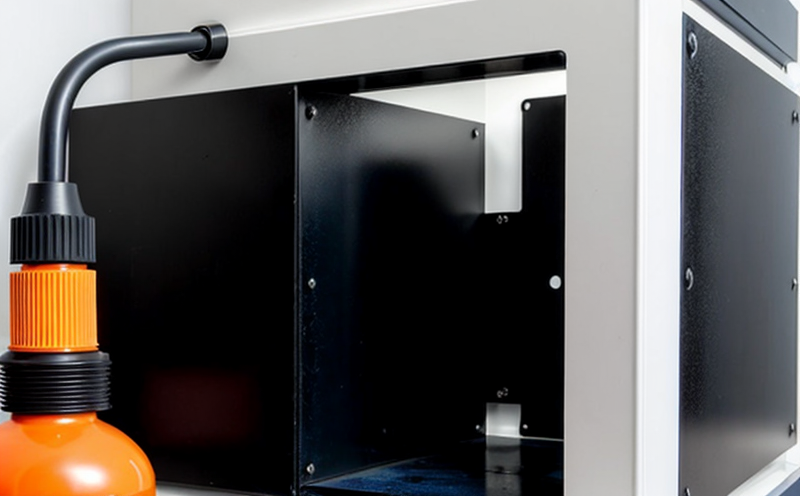ISO 4624 Pull Off Adhesion Strength Testing of Coatings
The ISO 4624 pull-off adhesion strength test is a critical procedure used in the characterization and quality assurance of coatings, including nanocoatings. This method assesses the cohesive properties of the coating to determine its resistance against delamination from an underlying substrate under controlled conditions.
This standardized procedure involves applying a force perpendicular to the surface of the specimen until failure occurs. The test is particularly valuable in ensuring that nano-coatings or surface treatments adhere effectively, which is essential for their intended performance and durability.
One key advantage of this testing method is its ability to provide insight into the adhesion strength between the coating and the substrate without requiring destructive sample removal. This is especially important when dealing with nanocoatings where the integrity of the specimen is crucial for accurate results.
The test setup typically includes a universal testing machine equipped with a specific type of fixture that can apply the necessary force in a controlled manner. Specimens are usually prepared by coating substrates and curing them according to specified protocols before undergoing the pull-off adhesion strength test.
Understanding the principles behind this test allows for better decision-making regarding material selection, process optimization, and quality control. For instance, if a nanocoating fails to meet the required adhesion standards during testing, it indicates potential issues with its formulation or application, prompting further investigation into these areas.
Incorporating ISO 4624 into your product development cycle can help ensure that your coatings perform as expected under various environmental and mechanical stresses. By adhering to this standard, you not only enhance the reliability of your products but also contribute towards maintaining industry best practices.
| Test Parameter | Description |
|---|---|
| Cohesive properties assessment | Evaluation of how well the coating bonds to the substrate. |
| Non-destructive evaluation | No need for sample removal during testing. |
| Environmental and mechanical stress simulation | Predicting real-world performance through controlled conditions. |
| Substrate Types | Description |
|---|---|
| Metallic surfaces | Suitable for testing coatings on automobiles and aircraft structures. |
| Polymeric substrates | A common choice for evaluating paints used in consumer electronics. |
| Ceramic materials | Relevant for aerospace applications requiring high-performance coatings. |
- Metallic surfaces: Ideal for assessing durability and protection against corrosion.
- Polymeric substrates: Suitable for evaluating colorfastness and scratch resistance.
- Ceramic materials: Pertinent for examining thermal stability and chemical resistance.
Understanding these parameters can help tailor the testing process to meet specific industry needs, ensuring accurate results that reflect real-world performance conditions.
The ISO 4624 pull-off adhesion strength test is an essential tool in nanocoatings & surface treatments quality assurance. It provides valuable insights into the cohesive properties of coatings and helps ensure they meet required standards for durability and reliability.
Industry Applications
The ISO 4624 pull-off adhesion strength test is widely used across various industries where coating quality and durability are paramount. Here are some key sectors that benefit from this testing method:
- Aerospace: Ensuring coatings on aircraft components can withstand harsh environmental conditions.
- Automotive: Verifying the longevity of protective coatings applied to vehicle exteriors.
- Electronics: Guaranteeing the integrity of thin film coatings used in semiconductors and printed circuits.
| Industry | Description |
|---|---|
| Aerospace | Testing for durability under extreme temperature changes and UV exposure. |
| Automotive | Evaluating resistance against abrasion, chemicals, and impact forces. |
| Electronics | Assessing thermal shock stability and electrical insulation properties. |
The versatility of this test makes it applicable to numerous applications within these industries. By adhering to ISO 4624, companies can maintain high standards in their product development processes, ensuring that coatings perform reliably under diverse conditions.
Why Choose This Test
The ISO 4624 pull-off adhesion strength test offers several advantages over other methods of assessing coating durability:
- Precise measurement: Provides accurate quantification of the cohesive properties of coatings.
- Non-destructive evaluation: Allows for repeated testing without compromising sample integrity.
- Standardized procedure: Ensures consistent results across different laboratories and test environments.
The ability to conduct non-destructive evaluations is particularly beneficial when dealing with nanocoatings, which are often thin and delicate. Using ISO 4624 ensures that these coatings can be tested without risking their structural integrity or compromising the quality of subsequent tests.
Moreover, standardization through this method helps align testing protocols globally, facilitating better communication between stakeholders involved in product development and manufacturing processes. This uniformity fosters trust among customers who rely on consistent performance from suppliers.
By choosing ISO 4624 for your coating quality assurance needs, you are ensuring that your products meet stringent international standards while providing reliable data that can be used to improve future iterations of your coatings.
Use Cases and Application Examples
The ISO 4624 pull-off adhesion strength test finds application in various scenarios where the integrity of nanocoatings is critical. Here are some examples:
| Scenario | Description |
|---|---|
| Aerospace coating durability | Evaluating coatings on satellite solar panels for long-term space exposure. |
| Automotive finish resilience | Assessing the ability of paint finishes to withstand road salt and abrasive debris. |
| Circuit board protection | Ensuring thin film coatings on electronic components can endure high-temperature soldering processes. |
In aerospace, this test ensures that coatings used in satellite solar panels can withstand prolonged exposure to space radiation and temperature fluctuations. In automotive manufacturing, it helps verify the durability of protective paint finishes against environmental factors such as salt spray and UV light. For electronics manufacturers, it guarantees the reliability of thin film coatings during high-temperature soldering processes.
These examples illustrate just a few ways in which ISO 4624 plays a crucial role in ensuring the quality and longevity of nanocoatings across diverse industries. By employing this standardized testing method, companies can confidently meet regulatory requirements while enhancing their product offerings.





